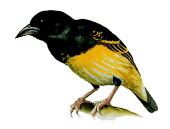Updated Monday, April 08 2013 at 00:00 GMT+3
By Philip Mwakio
The first known nesting site of one of the world’s rare
birds has been discovered in Dakatcha woodland, Kilifi County
According to Nature Kenya
Information indicates that until March 23, the breeding
ground of the endangered bird had remained unknown, puzzling
conservationists and researchers all over the world.
The Clarke Weaver is a bird found only in Kilifi County
in Kenya
‘’This will be a boost to tourism as bird lovers will
throng the site to see where these birds perch and thrive,’’ he said. The birds
had been seen in Arabuko-Sokoke Forest south of Sabaki River
They are usually in small flocks, feeding on insects and
fruits in forests. Their nesting site, however, had never been found.
But a monitoring team from Nature Kenya
Others included Julius Mwambire, Japhet Garama, Kazungu
Thuva, Samuel Kenga and Samson Katisho.
The nesting site is at a seasonal wetland comprising of
grasses and sedges surrounded by trees and bushes. “While observing the
weavers from the shade of low trees bordering the seasonal wetland, the team
noted brownish shapes of nests. One male was seen weaving more sedge strips
onto a nest,’’ Nature Kenya
The team estimated over 700 Clarke Weavers in the small
wetlands.

No comments:
Post a Comment